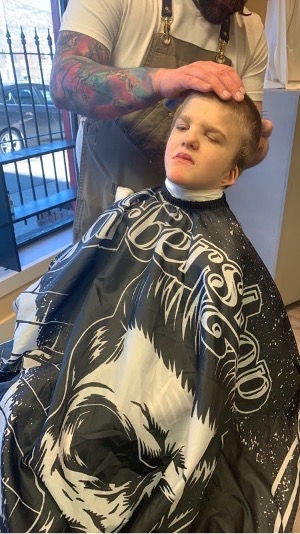
Contribution by Mary Hennig, Intervenor, SD 67
The student I support is an individual with deafblindness. He is profoundly deaf and uses ASL as his primary form of communication with picture symbols and photographs to supplement concept development and communication.
When the student was in grade 7, I asked his mom what one very difficult task for the family was to complete at home. I explained that we could make that a focus at school and try make it easier for everyone involved. Mom responded that cutting his hair was the task. It took several people to keep him still while the trimmer was used.
One morning, the student and I were in the community for a walk when we came across a local barber shop. I could see through the window that one of the barbers had a client receiving a haircut. Since my student had been having a good day, I suggested that we go inside and look around. My intention for the visit was to familiarize him with the space, and perhaps watch a haircut so that we could observe the expected behaviours of the person receiving the haircut. On entering we explored the retail items for sale and met staff at the reception desk. We asked to watch a haircut happening. The barber and the client both agreed so we watched the client’s haircut for about 10 minutes. I pointed out how the client was sitting still in the barber chair. We saw some of the tools being used (cape, sanitary paper at the neck, scissors, trimmers, brush).
After 10 minutes, I said that it was time to go and said that we could come back another day and watch again. The student I support slowly moved his hand and signed “haircut?” quite tentatively and with a questioning look on his face. I replied, “Oh, you want a haircut? We’ll have to come back another day.” The barber overheard us and leaned over to say, “I have an opening at 1:30. If you can come back, I can cut his hair then.”
I made a phone call to Mom, who gave her permission for the haircut to proceed. The appointment was booked, and we went back to school until it was time to go to the barber shop.
The barber told me that he cuts the hair of his two children who are on the autism spectrum and is used to accommodating for sensory issues. He recommended that the haircut start at the most ticklish spot (along the hairline) and then move to cutting the hair, and coming back to the neckline at the end, to allow him to have a sensory re-set. He let the student check out each piece of equipment and let him experience the vibrations and sensory input on the back of his hand.
The student I support did great! He sat so well that the barber offered to do a hair tattoo. The barber suggested carving a lightning bolt, and my student asked if he could have an “L” done instead (I think this may be because his name is an “L” signed at the outside corner of the left eye). The student walked out of the barber shop, feeling confident and proud. His communication influenced a change upon his world.
We often walk by that barber shop now, a few years later. If it’s slow in the store, the staff will come out to address the student by name and say they are looking forward to seeing him again soon. Mom can cut his student’s hair at home with the trimmers, using some of the same sensory techniques we learned from the barber. For a special treat, the student gets his hair cut at the same barber shop.
Getting a Haircut
Photos of a student getting a new haircut



